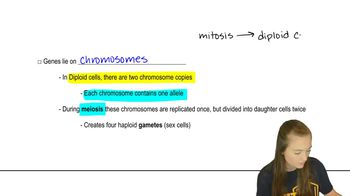Table of contents
- 1. Introduction to Genetics51m
- 2. Mendel's Laws of Inheritance3h 37m
- 3. Extensions to Mendelian Inheritance2h 41m
- 4. Genetic Mapping and Linkage2h 28m
- 5. Genetics of Bacteria and Viruses1h 21m
- 6. Chromosomal Variation1h 48m
- 7. DNA and Chromosome Structure56m
- 8. DNA Replication1h 10m
- 9. Mitosis and Meiosis1h 34m
- 10. Transcription1h 0m
- 11. Translation58m
- 12. Gene Regulation in Prokaryotes1h 19m
- 13. Gene Regulation in Eukaryotes44m
- 14. Genetic Control of Development44m
- 15. Genomes and Genomics1h 50m
- 16. Transposable Elements47m
- 17. Mutation, Repair, and Recombination1h 6m
- 18. Molecular Genetic Tools19m
- 19. Cancer Genetics29m
- 20. Quantitative Genetics1h 26m
- 21. Population Genetics50m
- 22. Evolutionary Genetics29m
17. Mutation, Repair, and Recombination
Types of Mutations
Problem 28a
Textbook Question
Yeast are single-celled eukaryotic organisms that grow in culture as either haploids or diploids. Diploid yeast are generated when two haploid strains fuse together. Seven haploid mutant strains of yeast exhibit similar normal growth habit at 25°C, but at 37°C, they show different growth capabilities. The table below displays the growth pattern.

Hypothesize about the nature of the mutation affecting each of these mutant yeast strains, including why strains B and G display different growth habit at 37°C than the other strains.
 Verified step by step guidance
Verified step by step guidance1
Understand the problem: The question involves analyzing the growth patterns of mutant yeast strains at different temperatures (25°C and 37°C). The goal is to hypothesize the nature of the mutations and explain why strains B and G behave differently at 37°C compared to the others.
Step 1: Recall that yeast can exist as haploid or diploid cells. Mutations in haploid yeast strains can directly affect their phenotype because there is no second allele to mask the mutation. This means that any mutation affecting growth at 37°C is likely due to a single defective gene in each strain.
Step 2: Analyze the growth patterns at 25°C and 37°C. Since all strains grow normally at 25°C, the mutations likely affect temperature-sensitive genes. These genes may encode proteins that are functional at lower temperatures but become misfolded or non-functional at higher temperatures (37°C).
Step 3: Hypothesize the nature of the mutations. For strains B and G, their different growth habits at 37°C suggest that the mutations in these strains may affect different pathways or genes compared to the other strains. For example, strain B might have a mutation in a gene involved in heat shock response, while strain G might have a mutation in a gene critical for cell division at higher temperatures.
Step 4: Consider genetic interactions. If strains B and G display unique growth patterns, it is possible that their mutations are in genes that interact with other cellular pathways differently than the mutations in the other strains. This could explain their distinct behavior at 37°C.
 Verified video answer for a similar problem:
Verified video answer for a similar problem:This video solution was recommended by our tutors as helpful for the problem above
Video duration:
2mPlay a video:
Was this helpful?
Key Concepts
Here are the essential concepts you must grasp in order to answer the question correctly.
Haploidy and Diploidy
Haploidy refers to cells that contain a single set of chromosomes, while diploidy indicates cells with two sets. In yeast, haploid strains can mate to form diploid cells, which can undergo meiosis to produce haploid spores. Understanding the difference between these two states is crucial for analyzing genetic mutations and their effects on growth under varying conditions.
Recommended video:
Guided course

Diploid Genetics
Temperature Sensitivity in Mutants
Temperature sensitivity in mutant strains refers to the phenomenon where certain mutations affect the organism's ability to grow or function at specific temperatures. In this case, the yeast strains exhibit normal growth at 25°C but show varied growth capabilities at 37°C, suggesting that the mutations may impact protein stability or enzymatic activity at higher temperatures.
Recommended video:
Guided course

Mutations and Phenotypes
Genetic Mutations and Phenotypic Expression
Genetic mutations are changes in the DNA sequence that can lead to alterations in an organism's phenotype, or observable traits. The differences in growth habits of strains B and G at 37°C compared to other strains may indicate specific mutations that affect metabolic pathways or stress responses, highlighting the relationship between genotype and phenotype in response to environmental changes.
Recommended video:
Guided course

Mutations and Phenotypes
Related Videos
Related Practice
Textbook Question
During mismatch repair, why is it necessary to distinguish between the template strand and the newly made daughter strand? Describe how this is accomplished.
660
views


